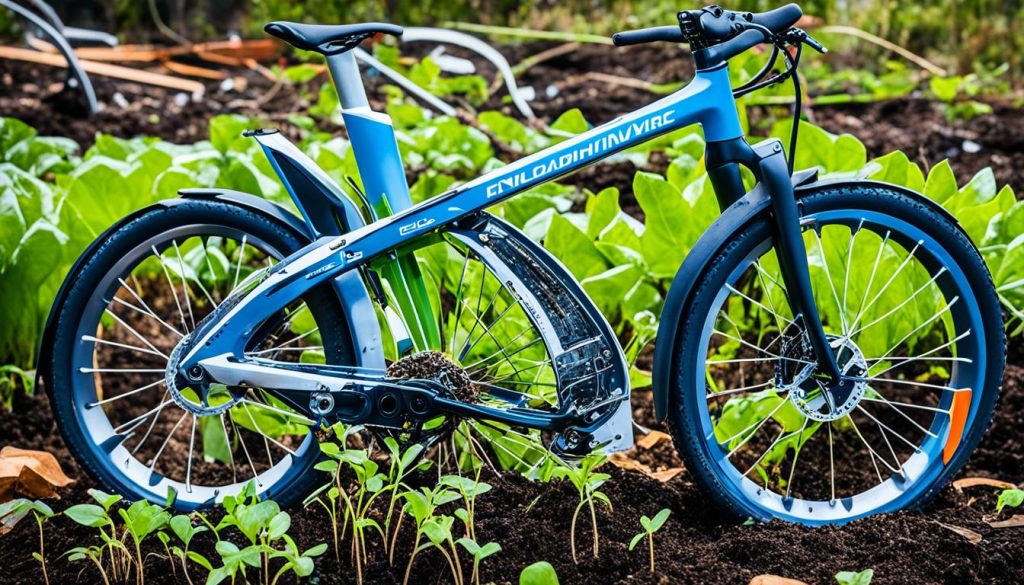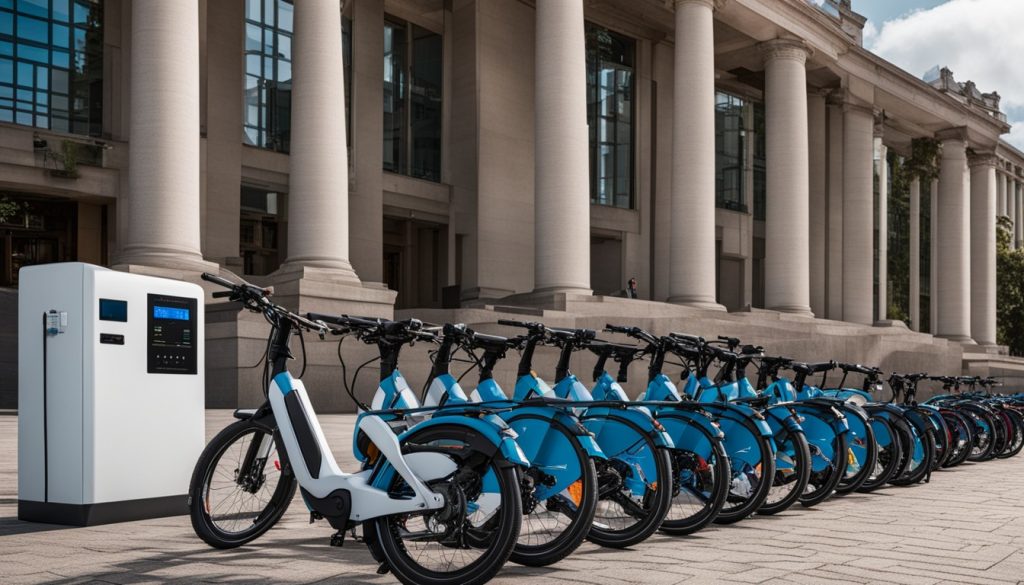I love cycling and caring for the planet. The e-bike industry is now using more eco-friendly ways to make bikes. They’re using sustainable e-bike materials and eco-friendly e-bike manufacturing methods. This makes city travel better for our planet.
Now, e-bikes use recycled e-bike components and renewable resources. Brands are using recycled plastics and bamboo to make their bikes. This cuts down on waste and helps the planet. It also means we can reuse materials more often.
I’m thrilled to see e-bikes leading the way to a greener future. By going green, e-bike makers are lowering their impact on the earth. They’re also showing other industries how to be more eco-friendly. I’m excited to see what’s next for eco-friendly e-bikes!
The Environmental Benefits of E-Bikes
I’m excited to talk about how e-bikes help the planet. They are becoming a popular choice for those who want to be eco-friendly. E-bikes are a great option because they don’t harm the environment like cars do.
Emissions Comparison: E-Bikes vs. Other Transportation Modes
The World Health Organization says e-bikes only produce 5 grams of CO2 per mile. Cars, on the other hand, release 266 grams of CO2 per mile. This shows how much better e-bikes are for the environment.
The German Environment Agency agrees. They say e-bikes are a clean and green way to get around. This makes e-bikes a top choice for those who care about the planet.
| Transportation Mode | CO2 Emissions (g/passenger-mile) |
|---|---|
| E-bike | 5 |
| Car | 266 |
| Motorcycle | 130 |
| Bus | 82 |
| Train | 65 |
The table shows e-bikes are much better for the environment than cars. Choosing an e-bike means you’re doing your part for a cleaner future.
Addressing the Biggest Challenges: Carbon Footprint of E-Bike Components
E-bikes are better for the planet than many other ways to travel. But, making them and the parts they use can still harm the environment. A study by Bosch eBike Systems and TÜV Rheinland found e-bikes create about 580 lbs of CO2 in their life.
The biggest part of this is the e-bike battery, making up over 50%.
To make e-bikes greener, companies are finding ways to lessen their impact. They’re using less CO2 plastics and tracing where battery cells come from to find ways to do better.
Sustainable E-Bike Components
Companies are working on making e-bike parts better for the planet. They’re doing this in several ways:
- Using recycled and renewable materials for frames, forks, and other parts
- Improving battery design and chemistry to cut down on manufacturing CO2
- Starting closed-loop recycling to get materials back from old batteries
- Working with suppliers for clear, green supply chains
Eco-Friendly E-Bike Manufacturing
Companies are also making their manufacturing greener. They’re doing things like:
- Switching to renewable energy for their factories
- Improving logistics and transport to cut down on emissions
- Starting waste reduction and recycling programs
- Working with others to find new, low-carbon ways to make products
By tackling the carbon footprint of e-bike parts and making, the industry is getting better at making these green transport options even greener.
| Component | Percentage of E-Bike Carbon Footprint |
|---|---|
| Battery | Over 50% |
| Frame and Other Parts | Less than 50% |
E-Bikes Eco-Friendly Materials and Manufacturing

The need for green transportation is growing. E-bike makers are using eco-friendly materials and processes. This makes e-bike production less harmful to the planet. It also brings new ideas to the industry.
More e-bikes are using materials from plants or recycled stuff. These materials are used for frames and other parts. They are a better choice than old materials.
E-bike makers are also working to make their production greener. They use less energy and reduce waste. They look for ways to use renewable energy too.
| Sustainable E-Bike Materials | Recycled E-Bike Components | Eco-Friendly E-Bike Manufacturing Processes |
|---|---|---|
|
|
|
The e-bike industry is getting greener with these new materials and ways of making things. As people care more about the planet, these green changes will be key in the future of e-bikes.
The Role of Government Regulations and Initiatives

Governments are key in making e-bikes more popular. They use policies and money to push for electric bikes as a green way to travel. For example, Germany gave a $900 million boost in 2020 to help people buy electric bikes. These actions are vital for the growth of eco-friendly e-bikes.
Financial Incentives and Infrastructure Support
They also work on making places better for e-bikes. This means putting in special charging spots and bike lanes. These changes make it easier and more appealing for people to use e-bikes, pushing for a greener way to get around.
| Country | Financial Incentives for E-Bikes | Infrastructure Support |
|---|---|---|
| Germany | $900 million stimulus package for e-bike purchases | Nationwide network of e-bike charging stations |
| Netherlands | Up to $1,500 in subsidies for e-bike purchases | Extensive network of dedicated e-bike lanes |
| France | Up to $700 in tax credits for e-bike purchases | Ongoing investment in urban bike-sharing programs |
These efforts by governments are key to growing the e-bike market and green transport. They offer money help and build up the places for e-bikes. This makes it easier for people to choose e-bikes, helping us move towards a greener future.
Durability, Recycling, and the Circular Economy
I’m thrilled to talk about how e-bikes are getting more sustainable. Now, companies focus on making e-bikes last longer and be recyclable. This means my e-bikes can keep me going for many years.
Companies are making e-bikes that last a long time. They want to help the planet by making a circular economy. They aim to make e-bikes easy to fix, reuse, and recycle. This helps reduce waste and protect the environment.
The industry is working hard to reuse and recycle materials. They have special programs to give old e-bike parts new life. When I need a new e-bike, I’ll look for ones that support recycling and sustainability.

